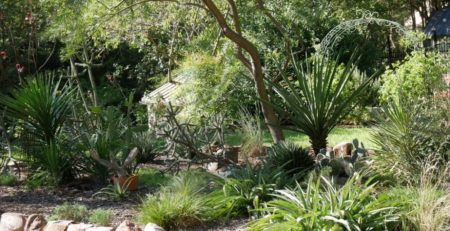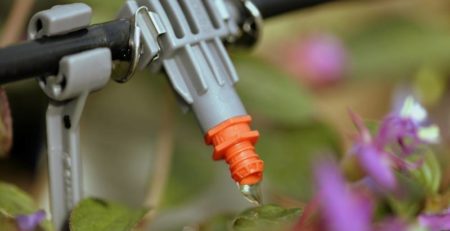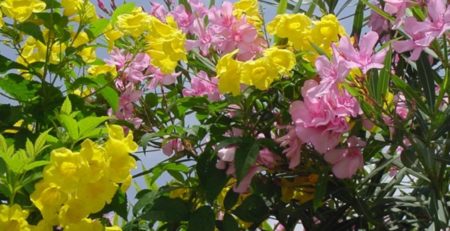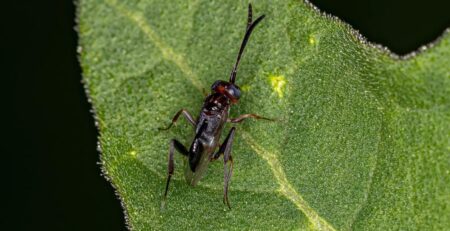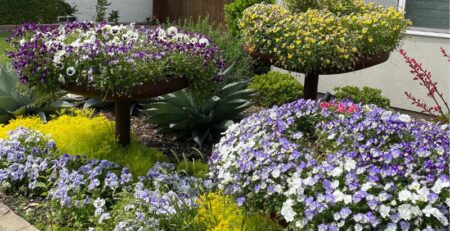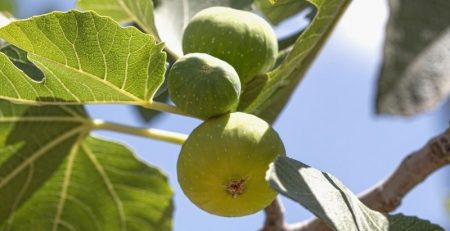Herbs in Containers
Would you enjoy the convenience of having fresh basil, oregano, and rosemary only two minutes from your kitchen? Try planting them in a container that can remain outdoors most of the year but can be moved into the garage when we are expecting one of our few winter freezes. The container makes a pretty contribution to the patio, and it is joyfully handy to simply step out your back door and snip some basil leaves for pesto. Pesto is very easy to make, by the way, and a bit of it can be stirred into a salad, spread lightly over grilled vegetables, or tossed into pasta for a superb dish. A pesto recipe is provided at the end of this article.
Herbs are beautiful plants, and the vast variety of leaves is amazing. Dill and fennel have the finest, most delicate little leaves, and Italian oregano, with its tiny round leaves, makes an incredible creeping plant drifting over the edge of your container. The same is true for thyme. There are the gorgeous gray-green leaves of curry and the fluffy bright green leaves of rue. The choices are only limited by availability, and even if you cannot find your favorite herbs at local garden centers, they can be ordered from online nurseries. I have had wonderful luck with ordering plants online, and on the three occasions when the plants were not up to my expectations, the companies immediately sent replacement plants.
When shopping for herb plants, make selections for each pot that require the same growing conditions. Some do not need as much sun or water as others. If your herbs will be in full sun all day, choose mint, lemon balm, lavender, and chamomile because they can withstand both full sun and heat. Rosemary, lavender, thyme, sage, and bay are the more woody-stemmed plants that thrive in full sun, but they may do okay in the shade. Plants that can be expected to do well in shade are basil, rosemary, oregano, tarragon, dill, and fennel. Yes, some plants are on both lists.
To build your container, first determine how many herbs you want it to hold, but keep in mind that you will probably need to move it into the garage or cover it with frost cloth a couple of times this winter. A container that is 12 inches diameter will easily hold four or five herbs. The pot does not have to be deep, since most herbs have very shallow roots. By the way, you certainly do not have to limit yourself to one container. Use a good potting soil that is loose and drains easily. When you bring your plants home from the garden center, place the little pots around the top of the soil until you find an arrangement you like. Dig the four or five holes with your garden trowel and put a teaspoon or two of bone meal or fertilizer in each. Remove each plant from its plastic pot and ruffle the roots, then place it into the soil and tamp it down before giving a light watering to the entire arrangement. And that is that! Check the soil for moisture every few days, then once the plants are established, once a week is often enough to water throughout the cool months. During hot summer days, they may need to be watered every two days. When the plants become tall and spindly, snip off the tops to encourage a fuller, bushier plant.
The benefits of herbs are many. They are perfectly low calorie, low fat, low sodium, and have antioxidant benefits. Some herbs, including catnip, chives, cilantro, dill, and fennel are considered pollinator friendly plants. One of them, the very controversial cilantro (the Spanish word for coriander), is said to be a flavor that you either love or hate. The leaves resemble parsley, but the flavor is stronger. It has become incredibly popular in our part of the country and is generously served alongside or within many Mexican dishes.
One of my favorite recipes for the use of a fresh herb is one a friend gave me years ago for dill scalloped potatoes. You can easily find several recipes online for this fabulous dish. Scalloped potatoes are always a favorite, but with fresh dill as an ingredient they are spectacular. Herbs are decorative as well as tasty. Enhance your plate presentation with a spray of parsley, add a sprig of mint to a glass of iced tea, sprinkle chopped chives over baked potatoes, or rub chopped fresh rosemary over chicken before roasting. Most herbs can be dried for later use and if you are fond of Italian food, grow oregano, rosemary, basil, and thyme. You might want to dry the leaves of some of them and store in little spice jars to keep on hand for later, maybe dried oregano to sprinkle over pizza.
Recently some of our own Dallas County Master Gardeners, including Cynthia Jones and her daughter Nicole Jones, attended an advanced training session on herbs presented by the Collin County Master Gardeners. Cynthia reports that one of the notable things she learned is the amazing variety of herbs and their wide array of uses. They are not just for flavoring foods, but also for cleaning products, pest deterrents, cosmetics, medications, teas, soothing lotions, and salves, and so much more! The possibilities seem virtually endless, and so many of them can be grown right in your own garden! Nicole, an elementary school teacher, has enjoyed introducing her first graders to the calming effect of some of the aromatic herbs she grows in her school garden, often allowing children to sample the leaves and crush them, releasing their soothing, delightful aromas.
Consider yourself encouraged and start searching for your favorite herbs to get a container or two underway. Enjoy!
Here is the recipe for Pesto:
3 cups of basil leaves
¾ cup grated parmesan cheese
½ cup of olive oil
1/4 cup of pine nuts
4 cloves of garlic
2 teaspoons of lemon juice (optional)
Combine all ingredients in a food processor or blender and blend until smooth. That is all there is to it!!
This recipe makes just over one cup of pesto. The pesto lasts three days stored in the refrigerator in a tight container, or can be frozen for up to three months. Separate into several portions if freezing (an ice cube tray works well), so you will not have to thaw all the pesto when you want only a dollop.


